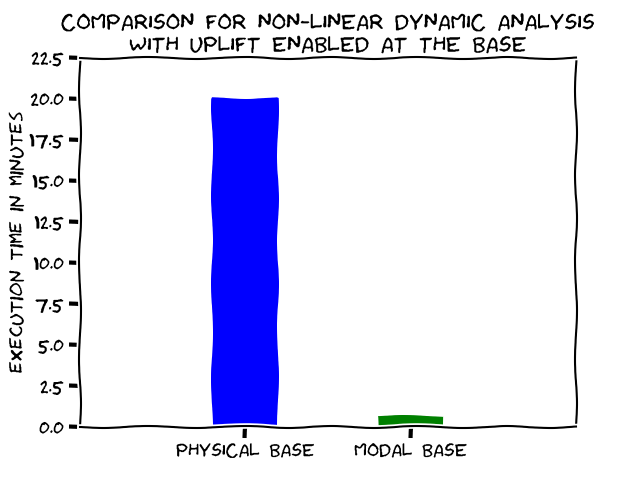A number of examples for the open-source Finite Element Solver Code_Aster and Salome_Meca
Each folder contains a .med file with the mesh of the structure and a .comm file with the command file for Code_Aster. With these files anyone shoulf be able to reproduce the analyses with or without Salome_Meca. See the IFC2CA video if you want to see how to reproduce the analyses with asterStudy, a dedicated module of Salome_Meca.
Tutorials 01-03: Static analysis of a cantilever beam with 3D solid elements and post-processing of results
Tutorials 04-06: Steady-state thermo-mechanical analysis of a cantilever beam with 3D solid elements
Tutorial 07: Static analysis of a cantilever beam with beam elements and post-processing of results
Tutorial 08: Static analysis of a cantilever beam with shell elements and post-processing of results
Tutorial 09: Calculation of reinforcement density for shell elements
Tutorial 10 - Connect Non-Conformal Meshes: Connect non-conformal meshes, that is, meshes with interface boundaries in which the mesh node locations are not identical.
Tutorial 11 - Connect Conformal Meshes: Connect conformal meshes, that is, meshes with interface boundaries in which the mesh node locations are identical.
Tutorial 12 - Connect Objects With "Partition" Command: Use of the "partition" command in GEOM module of Salome_Meca to connect objects and obtain a single object to be meshed, similarly to "Union" operation in other software.
Tutorial 13 - Modal Analysis with Solid Elements: perform a modal analysis of a 3D model with solid elements.
Define Local Axes for 1D Elements: Define the orientation of the local axes of 1D elements in Code_Aster and extract this information in the result file, then visualize the local axes in Paraview
Define Custom Beam Profile: Define a custom profile for beam elements given that these properties are calculated beforehand or extracted from a table. Extract not only the generalized forces but also the maximum stresses for each type of response
Composite Shells: Define a composite shell with an arbitrary number of layers, orhtotropic materials and arbitrary material directions and extract generalized forces and stress for a specific layer. BONUS: Example is performed with a Cross Laminated Timber (CLT) panel
Parametric Study: Setup and perform a parametric analysis based on the composite shell example and by modifying the orientation of the layers of the panel from an initial angle of 0 to a final angle of 90 degrees with a step of 10. This tutorial is based on modifying the command file with python outside the asterStudy module. It does not cover the case of a parametric geometry.
Tensegrity Structure Example: Nonlinear dynamic analysis of a tensegrity structure with Code_Aster
Tensegrity Structure Seismic Example: Nonlinear dynamic analysis of a tensegrity structure under ground excitation with Code_Aster
IFC2CA Portal Example: Download the IFC2CA example files and load them in Salome_Meca. Here you can find the files for the portal_01 example
Note: The repository referenced in the video has been moved in the IfcOpenShell/analysis-models repository
Rod Example: Perform a multi-step static analysis with material and geometric nonlinearity, using an elasto-plastic material model with kinematic hardening and a logarithmic strain for geometric nonlinearity in large deformations. Moreover, use a Jupyter Lab notebook to do some basic pre- and post-processing based on the input and output files.
Linear Dynamic Analysis Example: Run a linear transient dynamic analysis of a building structure based on an acceleration ground-motion time-history, after performing a modal analysis and assigning a classical damping matrix based on user-defined damping ratios for each mode. Moreover, use a Jupyter Lab notebook to do some basic post-processing based on the output test files that are created.
Linear Dynamic Analysis Example with Modal Base: Run a linear transient dynamic analysis of a building structure based on an acceleration ground-motion time-history, using a modal base of the structure; that is the mode shapes from a modal analysis. Modify the input file with respect to the standard dynamic analysis that uses a physical base to define the modal base, assign a classical damping matrix based on damping ratios for each mode, and restore back the results from the modal to the physical base, in order to extract the displacement time-histories in an external 'resu' file.
Nonlinear Dynamic Analysis Example: Run a nonlinear transient dynamic analysis of a building structure with nonlinear discrete elements that allow uplifting and rocking of the structure at the base.
Nonlinear Dynamic Analysis Example with Dynamic Sub-Structuring: Run a nonlinear transient dynamic analysis of a building structure with nonlinear discrete elements that allow uplifting and rocking of the structure at the base. The part of the structure that remains elastic is sub-structured in a super-element using the Craig-Bampton dynamic sub-structuring method.
All content is licensed under an open-source, 'copyleft' license:
Attribution-ShareAlike 4.0 International (CC BY-SA 4.0)


